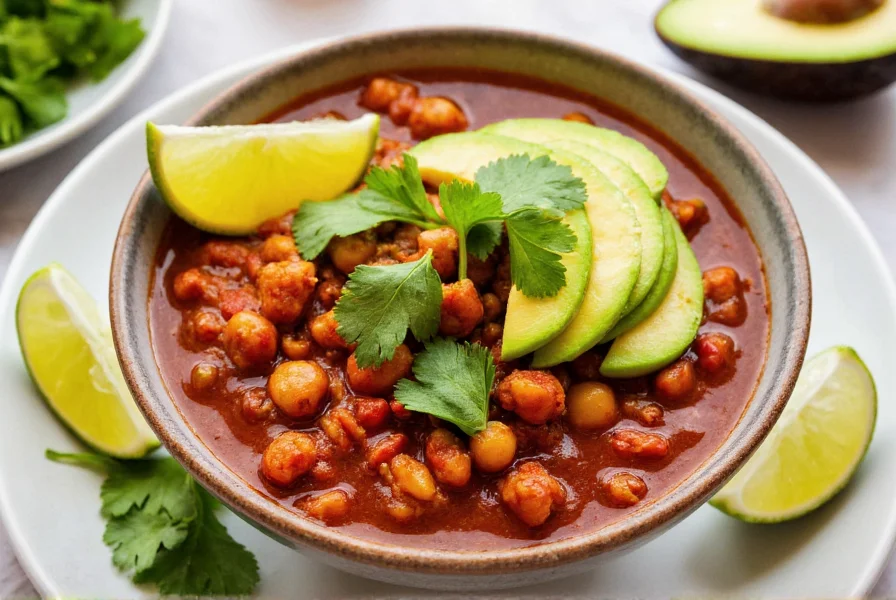Creating exceptional chili without meat isn't just possible—it's often more flavorful and nutritionally balanced than its meat-based counterpart. Many home cooks mistakenly believe that removing meat automatically means sacrificing depth and heartiness, but this couldn't be further from the truth. The foundation of great meatless chili relies on building complex flavors through strategic ingredient layering and proper cooking techniques.
The Science Behind Flavorful Meatless Chili
Meat contributes fat, protein, and umami compounds that give chili its characteristic richness. When making chili without meat, you need to replace these elements with plant-based alternatives. Umami—the fifth taste sensation—is particularly crucial for creating that "meaty" satisfaction without actual meat.
Key umami powerhouses for meatless chili include:
- Tomato paste (cooked until caramelized)
- Mushrooms (especially cremini or shiitake)
- Soy sauce or tamari
- Smoked paprika
- Nutritional yeast
- Roasted garlic
Essential Ingredients for Perfect Meatless Chili
While traditional chili recipes rely on ground beef or turkey, the best vegetarian chili substitutes focus on texture variety and protein density. Here's what makes a truly exceptional meatless chili:
| Ingredient Category | Top Recommendations | Why It Works |
|---|---|---|
| Protein Base | Black beans, kidney beans, pinto beans, lentils | Provide hearty texture and complete protein profile when combined |
| Meat Substitute | Chopped mushrooms, textured vegetable protein (TVP), walnuts | Mimic meat's texture while adding umami depth |
| Flavor Builders | Smoked paprika, cumin, cocoa powder, coffee | Create complex, "meaty" flavor notes without meat |
| Texture Enhancers | Roasted sweet potatoes, diced eggplant, quinoa | Add variety and heartiness to each bite |
Classic Vegetarian Chili Recipe
This tested recipe delivers restaurant-quality meatless chili with deep, complex flavors that satisfy both vegetarians and meat-eaters alike. The secret? A three-stage flavor development process that builds layers of taste.
Ingredients
- 2 tablespoons olive oil
- 1 large onion, diced
- 4 cloves garlic, minced
- 8 oz cremini mushrooms, finely chopped
- 1 red bell pepper, diced
- 2 tablespoons tomato paste
- 2 tablespoons chili powder
- 1 tablespoon ground cumin
- 1 teaspoon smoked paprika
- 1/2 teaspoon cocoa powder
- 2 (15 oz) cans mixed beans (kidney, black, pinto), drained and rinsed
- 1 (28 oz) can crushed tomatoes
- 1 cup vegetable broth
- 1 cup cooked brown lentils
- 1 tablespoon soy sauce
- 1 teaspoon maple syrup
- Juice of 1 lime
Step-by-Step Instructions
- Sauté aromatics: Heat olive oil over medium heat. Cook onions until translucent (5 minutes), then add garlic and mushrooms. Cook until mushrooms release their liquid and begin to brown (8-10 minutes).
- Build flavor base: Stir in tomato paste and cook until it darkens slightly (2-3 minutes). Add all spices and toast for 1 minute until fragrant.
- Simmer chili: Add beans, tomatoes, broth, lentils, soy sauce, and maple syrup. Bring to a simmer, then reduce heat to low. Cover and cook for 45-60 minutes, stirring occasionally.
- Finish and serve: Remove lid and simmer uncovered for 15 minutes to thicken. Stir in lime juice. Adjust seasoning as needed.

Common Meatless Chili Mistakes to Avoid
Even experienced cooks make these critical errors when preparing chili without meat:
- Skipping the mushroom step: Mushrooms provide essential umami and texture. Don't rush their cooking—let them develop a deep brown color.
- Using only one bean variety: Multiple bean types create textural interest that mimics the varied texture of ground meat.
- Not building flavor layers: Proper meatless chili requires sequential flavor development, not just dumping everything in the pot.
- Over-relying on meat substitutes: Many commercial meat alternatives contain fillers that break down in chili. Whole food ingredients work better.
- Underseasoning: Plant-based ingredients often require more seasoning than meat to achieve balanced flavor.
Nutritional Benefits of Meatless Chili
Chili without meat offers significant health advantages while delivering comparable satisfaction:
- Higher fiber content (15-20g per serving vs 5-8g in meat chili)
- Lower saturated fat (typically 2-3g vs 10-15g in meat versions)
- Rich in plant-based protein (15-20g per serving)
- Higher antioxidant levels from diverse vegetables and spices
- Better for heart health and digestive wellness
Variations for Special Dietary Needs
One of the advantages of meatless chili is its adaptability to various dietary requirements:
- Vegan version: Ensure all ingredients are plant-based (check broth and chocolate)
- Gluten-free: Naturally gluten-free when using certified GF broth
- Lower-carb: Reduce beans and add more mushrooms, eggplant, and zucchini
- Spicier version: Add chipotle peppers in adobo sauce or cayenne pepper
- Milder version: Use mild chili powder and remove seeds from any fresh peppers

Serving Suggestions and Leftover Tips
Meatless chili often tastes even better the next day as flavors continue to meld. For optimal results:
- Store in airtight container for up to 5 days or freeze for 3 months
- Reheat gently on stove with a splash of broth to restore moisture
- Top with avocado, vegan sour cream, or dairy-free cheese
- Pair with cornbread, rice, or a simple green salad
- Use leftovers as a topping for baked potatoes or nachos
Frequently Asked Questions
Can chili without meat be as hearty as traditional chili?
Yes, absolutely. By combining multiple bean varieties, lentils, and texture-rich ingredients like mushrooms and roasted vegetables, meatless chili can achieve comparable heartiness. The key is building layers of flavor through proper cooking techniques rather than relying solely on meat for substance.
What's the best substitute for ground beef in chili?
Finely chopped mushrooms provide the most authentic meat-like texture and umami flavor. For a different approach, cooked lentils combined with walnuts (pulsed in a food processor) create an excellent "meaty" texture with rich flavor. Avoid over-relying on processed meat substitutes, which often break down in chili.
How do you make vegetarian chili taste "meaty" without actual meat?
The secret lies in umami-rich ingredients: cook tomato paste until caramelized, use smoked paprika, add a splash of soy sauce, and include mushrooms. A small amount of instant coffee or dark chocolate (cocoa powder) also enhances the deep, complex flavors associated with meat-based chili without adding actual meat.
Does meatless chili have enough protein?
Yes, a well-constructed meatless chili provides ample protein. Combining different beans and lentils creates a complete protein profile. A typical serving contains 15-20 grams of protein—comparable to meat-based chili—while offering additional fiber and nutrients that meat lacks.
How long should vegetarian chili simmer for best flavor?
For optimal flavor development, simmer meatless chili for 45-60 minutes after bringing to a boil. The longer simmering time allows flavors to meld and plant-based ingredients to fully absorb the spices. Unlike meat chili, vegetarian versions won't become tough with extended cooking, so you can safely simmer for up to 2 hours for even deeper flavor.











 浙公网安备
33010002000092号
浙公网安备
33010002000092号 浙B2-20120091-4
浙B2-20120091-4